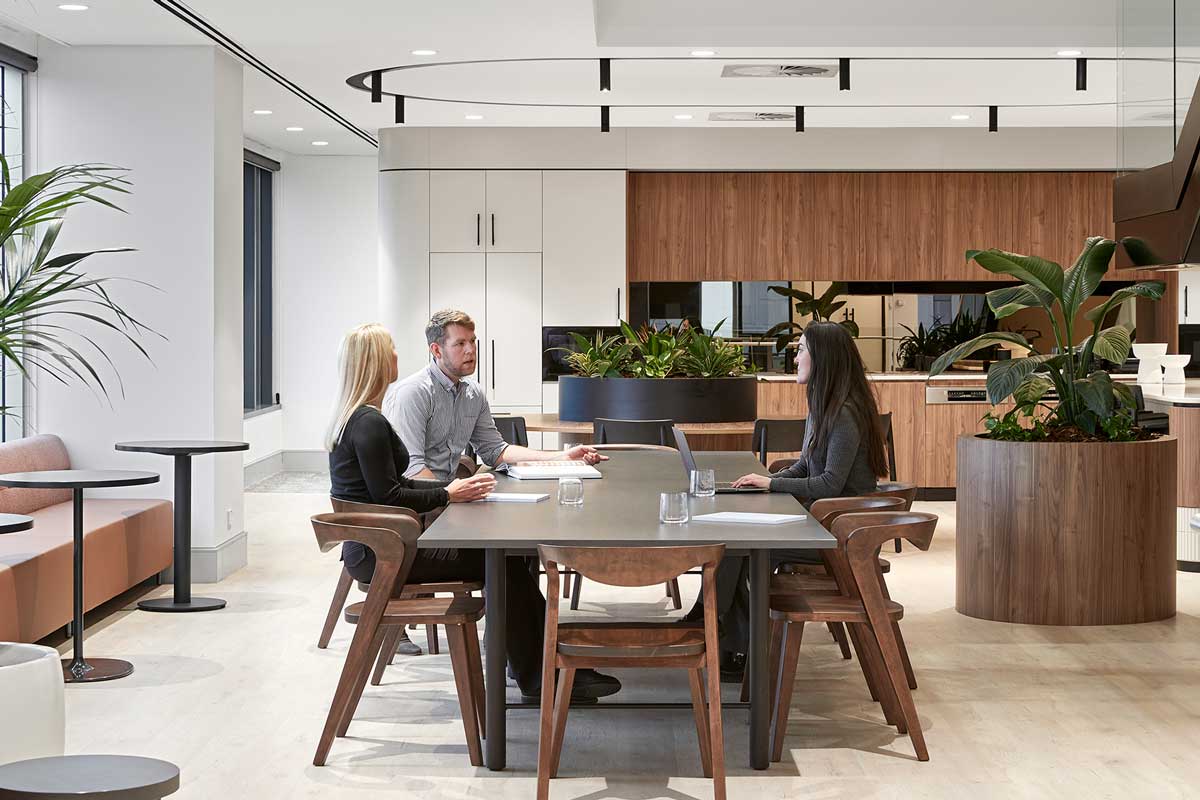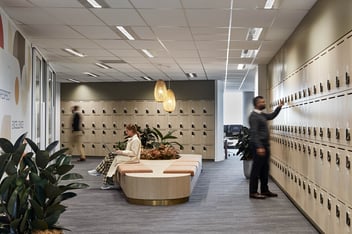
10 ways to create a Purpose Led, People Centred Workplace

What is the value of a purpose led, people centred workplace?
At the heart of every business is its people. An unhappy team of people leads to mediocre performance at work, high staff turnover and cultural issues, including lack of collaboration and innovation. If a business has ongoing problems like this, eventually the quality of services and products are affected, and this impacts the bottom line.
Being aware of these problems is one thing, but overcoming it is another. Despite their best efforts many companies are unsure how to create a workplace strategy that will improve the happiness and wellbeing of employees and in turn improve the culture and performance.
That is why this year, Axiom in conjunction with the Global Workplace Collective hosted the “Purpose Led, People Centred” events in Australia and the USA. We invited industry experts to come together and discuss their firsthand experiences and share how they solved these familiar challenges to build their own “Purpose led, People Centred" workplaces and boosted their businesses success.
The Panelists
Our panelists represented several industries including, finance, legal, insurance, law, mining, telecommunications, hospitality, and technology. With expertise in people & culture, facilities, operations and leadership, the panelists were invited to share their innovative ideas to inspire our guests to think creatively, future proof working models and the physical workplace with a “Purpose Led, People Centred” culture. (See the full list of panelists at the end of this article.)
The Top 10 Drivers to Foster a Purpose Led, People Centred Workplace
Whilst there were many ideas shared, there were 10 key themes that were discussed and agreed as the top drivers to foster a purpose led, people centred workplace. From location to socialisation, the panelists offered insights on the elements shaping modern work environment. These themes invested in the employee experience to help build community, increase productivity, and improve work satisfaction.

1. Socialisation boosts productivity
Based on Harvard's research on happiness, maintaining social connections and meaningful relationships is ranked as the second most crucial factor. The study also revealed that upon retiring, individuals often miss the social bonds and connections established in the workplace. Our panelists discussed strategies for fostering a culture that promotes socialisation, emphasising the importance of human interaction in the workplace.
Returning to the office post-pandemic highlighted the significance of building relationships, as it contributes to collaboration, innovation, and overall productivity. Although remote work may offer focused productivity, the lack of in-person connection can hinder employees' sense of belonging and investment in the company's success.
2. Employees drive continuous improvement
Based on the experience of panelist Dr Paul Luciani, Asia Pacific & India Real Estate Leader at Ernst & Young, a successful workplace encourages a culture of continuous improvement. A critical factor is maintaining an employee feedback loop, feedback helps employees understand their performance levels, motivates progress, and identifies areas for growth. Incorporating feedback at all levels ensures that evolving workplace needs are effectively met, allowing for continuous improvement and effective decision-making.
3. Engaging the senses for better work
The panelists highlighted the importance of incorporating elements such as plants, natural light, acoustics/sound, and natural materials in the workplace to promote social cohesion and enhance employee happiness. A study published by the National Library of Medicine in America in 2023 found that incorporating a high number of plants can have positive effects, including reducing stress, improving air quality, and increasing satisfaction with the workspace.
Additionally, strategic lighting with the right wattage and colour can have a significant impact on creating environments that support employee well-being. Poor lighting, on the other hand, can contribute to both physical and mental fatigue, leading to feelings of anxiety and burnout. By implementing appropriate lighting systems, workplaces can create a safe and comfortable environment that maximises concentration and productivity, ultimately boosting job satisfaction and overall performance.
4. Location matters
Selecting a workplace location that caters to the holistic needs of employees is crucial in attracting and retaining top talent. Today's workforce seeks more than just a pay cheque - they value a sense of belonging and a positive impact on their lives. Opting for a location with convenient access to main roads, public transport, shopping, gyms, parking, and amenities can greatly enhance the overall well-being of employees, both physically and mentally. Energising surroundings can contribute to a positive atmosphere, further enriching the workplace environment.
5. Infusing Hospitality into the Workplace
Integrating hospitality into the workplace has become a popular trend that enhances employee well-being. In today's dynamic work environment, employees seek services and amenities that cater to their daily needs. Panelist, Travis Foster from RAC highlighted the concierge service and central cafe available to employees on-site, providing a convenient space for rejuvenation, informal gatherings, and social connections. Paul Lulic from South 32 agreed, saying "It’s about creating environments and experiences that eliminate workday friction and resonate deeply with their employees’ needs for comfort, belonging, and connection". With the rise of hybrid work models, there is a greater emphasis on achieving a harmonious balance between work and personal life. It is essential to cultivate a welcoming and comfortable atmosphere for employees and guests, offering a range of amenities such as on-site laundry services and diverse food options. These offerings not only attract and retain employees but also empower them to manage their personal priorities effectively within the workplace.
“It’s about creating environments and experiences that eliminate workday friction and resonate deeply with their employees’ needs for comfort, belonging, and connection.” Paul Lulic, Senior Manager Global Workplace at South 32
6. Magnetise, Don't Mandate Office Attendance
Companies that mandate office attendance may see a negative impact on employee morale, resulting in higher rates of absenteeism, a weaker company culture, and lower employee retention. To overcome these obstacles, create an inviting office environment with a campus-like atmosphere, featuring collaborative and innovative spaces. Incorporating amenities such as cafes, wellness areas, and end of trip facilities will make the workplace more enjoyable for employees, magnetising them to the office.
7. Test With a Pilot Space
Data and strategy can be utilised to guide space planning and office design decisions. Testing out a pilot design within an organisation allows for observation of how they interact in the new layout, before implementing it throughout the entire workplace, and by collecting feedback from team members using the space, design plans can be adjusted to maximise effectiveness. This ensures the design aligns with accurate usage patterns and preferences. South 32 has seen significant success with this approach in their workplace designs. Pilot spaces help organisations future-proof their design by adapting it to real-time needs.
8. Future-proofing with technology
Incorporating cutting-edge technology can greatly enhance workplace happiness, health, and productivity. A survey conducted by Axiom's wrkx INDEX TM revealed that many employees feel technology in the workplace is lacking, highlighting the importance of functional and seamless technology for workplace success. By providing employees with advanced technology, they can focus on critical tasks effectively, ultimately driving the organisation towards success.
9. Prioritising ESG
Organisations that incorporate ESG into their workplace structure give greater attention to their employees' care and comfort. By focusing on the wellbeing of individuals, and the wider community, social and environmental improvement can be achieved. This can be as simple as conducting regular surveys to measure job satisfaction and morale, or helping employees set up professional goals to grow their career, or sourcing ethically made cleaning products to the lower environmental impact of the office.
10. Improve Culture of Collaboration with a Top-Down Approach
All the panelists unanimously agreed that fostering a culture of collaboration and performance hinges on the abundance of collaborative spaces in the workplace. They acknowledged that certain organisations may encounter challenges with this transition, especially those accustomed to traditional office setups with 1 to 1 desk allocation and closed-off spaces for senior managers.
In situations where a full workplace redesign is not applicable, businesses can make subtle upgrades by switching to customisable furniture, by which spaces can be transformed for different purposes. Fundamentally, a new collaborative work style is facilitated through effective change management, starting from the top-down with full support from the senior management team.
Conclusion
Establishing a sense of purpose at work, coupled with creating experiences that employees eagerly anticipate, can undeniably enhance the overall culture and performance within the workplace. While each workplace varies, constraints such as budget limitations or business regulations may impact the ability to implement all suggested tips. Nonetheless, these strategies can serve as a valuable framework that can be tailored to suit the specific needs of your organisation.
For assistance with workplace strategies tailored to improve culture, employee attendance, and address space needs for hybrid work, contact our workplace strategist.
Thank you to our panelists:
Dr Paul Luciani Asia Pacific & India Real Estate Leader at Ernst & Young
Alexandra Brook Workplace Lead at Optus
Zrinka Lovrencic CEO of WRK +
Garry Slater Director of Strategy and Design at Axiom Workplaces
Chris Low Head of Vibe at Canva
Dean Rikanovic Global Workplace Designer at Rikanovic
Travis Foster Head of Property & Facilities at RAC
Paul Lulic Senior Manager Global Workplace at South 32
Emma Elliott CEO at ALPMA
Nadia Paulse Senior Design Associate at Axiom Workplaces





